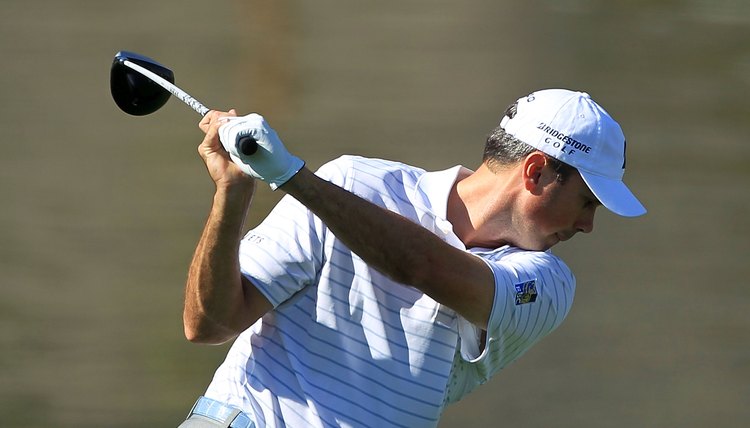The rotary golf swing is based in large part on the “one-plane vs. two-plane” swing philosophy. The idea that there are two basic types of swings was pioneered by golf instructor Jim Hardy, according to the Golf Channel’s Martin Hall. Golf writer Jeffrey Mann call’s Hardy’s description of the one-plane swing the “prototypical” rotary swing. The key to the rotary swing is to rotate the body around a fixed spine position. Mann says the rotary swing’s “primary mantra is ABT (always be turning).” A one-plane swing should yield more consistent results “if you are a fairly fit, flexible and powerful player,” writes Stina Sternberg in “Golf Digest.”
Step 1
Take a strong-to-neutral grip, advises Australian golf coach Sam Letourneau. In a strong grip the hands are turned slightly clockwise -- to the right -- so that the "V" formed by the thumb and forefinger of the left hand points to the right shoulder.
Step 2
Bend from the hips.
Letourneau advises golfers to tilt forward about 35 to 40 degrees, and to set their feet slightly wider than shoulder length. Sternberg notes that rotary golfers should stand farther from the ball than those who take an upright stance and should maintain their forward tilt through the entire swing.
Step 3
Step 4
Step 5
Turn the left side of your body (for a right-handed player) toward the target to begin the downswing. This leads the club head back to the ball. “The arm movement is actually quite passive at the start of your downswing,” said Letourneau.
Step 6
Allow the the club head to return to the ball along the same path it took on the backswing. O’Connell notes that the rotary motion should pull the club head to the inside of the target line immediately after impact.

